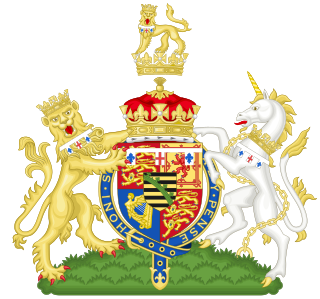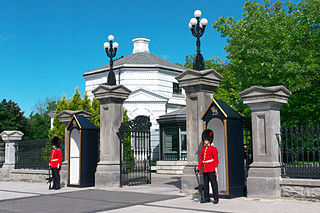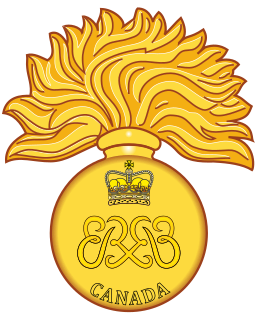
Adrienne Louise Clarkson (Chinese: 伍冰枝; pinyin: Wǔ Bīngzhī; Jyutping: Ng5 Bing1-zi1; née Poy; born February 10, 1939) is a Hong Kong-born Canadian journalist who served from 1999 to 2005 as Governor General of Canada, the 26th since Canadian Confederation.

Prince Arthur, Duke of Connaught and Strathearn, was the seventh child and third son of Queen Victoria of the United Kingdom and Prince Albert of Saxe-Coburg and Gotha. He served as Governor General of Canada, the tenth since Canadian Confederation and the only British prince to do so. In 1910 he was appointed Grand Prior of the Order of St John and held this position until 1939.

Duke of Connaught and Strathearn was a title in the Peerage of the United Kingdom that was granted on 24 May 1874 by Queen Victoria of the United Kingdom of Great Britain and Ireland to her third son, Prince Arthur. At the same time, he was also granted the subsidiary title of Earl of Sussex.

Major General Alexander Cambridge, 1st Earl of Athlone, was a British Army commander and major-general who served as Governor-General of the Union of South Africa and as Governor General of Canada.

Princess Victoria Patricia Helena Elizabeth of Connaught, later Lady Patricia Ramsay, was a granddaughter of Queen Victoria. Upon her marriage to Alexander Ramsay, she relinquished her title of a British princess and the style of Royal Highness.

Rideau Hall is the official residence in Ottawa of both the Canadian monarch and his or her representative, the governor general of Canada. It stands in Canada's capital on a 36-hectare (88-acre) estate at 1 Sussex Drive, with the main building consisting of approximately 175 rooms across 9,500 square metres (102,000 sq ft), and 27 outbuildings around the grounds. Rideau Hall's site lies outside the centre of Ottawa. It is one of two official royal residences maintained by the federal Crown, the other being the Citadelle of Quebec.

Alastair Arthur Windsor, 2nd Duke of Connaught and Strathearn was a member of the British Royal Family. He was the only child of Prince Arthur of Connaught and Princess Alexandra, 2nd Duchess of Fife. He was a great-grandson of Queen Victoria through his father and the first great-grandchild of Edward VII through his mother. He was also a descendant of Victoria's paternal uncle and predecessor, William IV, through an illegitimate line.

Princess Louise Margaret of Prussia, later Duchess of Connaught and Strathearn, was a member of the House of Hohenzollern and of the British royal family. She served as the viceregal consort of Canada while her husband, Prince Arthur, Duke of Connaught and Strathearn, served as the governor general, from 1911 to 1916.

Princess Patricia's Canadian Light Infantry is one of the three Regular Force infantry regiments of the Canadian Army of the Canadian Armed Forces. Formed in 1914, it is named for Princess Patricia of Connaught, daughter of the then-Governor General of Canada. The regiment is composed of three battalions, for a total of 2,000 soldiers. The PPCLI is the main lodger unit of Canadian Forces Base (CFB) Edmonton in Alberta and CFB Shilo in Manitoba, and attached to 3rd Canadian Division; as such, it serves as the "local" regular infantry regiment for much of Western Canada. The Loyal Edmonton Regiment (LER), a Reserve Force battalion, is affiliated with the PPCLI but is not formally part of it. As part of this affiliation, the LER carries the designation '4th Battalion, Princess Patricia's Canadian Light Infantry'.

New Edinburgh is a neighbourhood in Rideau-Rockcliffe Ward, in Ottawa, Ontario, Canada. It is located to the northeast of the downtown core. It is bordered on the west by the Rideau River, to the north by the Ottawa River, to the south by Beechwood Avenue, and on the east by Springfield Road and the former Rockcliffe Park village limits.

The Canadian Grenadier Guards (CGG) is a reserve infantry regiment in the 34 Canadian Brigade Group, 2nd Canadian Division, of the Canadian Army. The regiment is the oldest and second-most-senior infantry regiment in the Primary Reserve of the Canadian Army. Located in Montreal, its primary role is the provision of combat-ready light infantry troops in support of Canadian regular infantry. It is a Household Foot Guard regiment and also provides soldiers for public ceremonial duties, performing similar ceremonial duties to the Guards regiments of the British Army. This primarily entails mounting the guard on Government House, the Governor General's residence, and performing the "Changing the Guard" ceremony on Parliament Hill in Ottawa, a task it shares with Canada's senior Household Foot Guard regiment, the Governor General's Foot Guards of Ottawa. The Canadian Grenadier Guards is an allied regiment to the British Grenadier Guards.

The Governor General's Foot Guards (GGFG) is the senior reserve infantry regiment in the Canadian Army. Located in Ottawa at the Cartier Square Drill Hall, the regiment is a Primary Reserve infantry unit, and the members are part-time soldiers.

The viceregal consort of Canada is the spouse of the serving governor general of Canada, assisting the viceroy with ceremonial and charitable work, accompanying him or her to official state occasions, and occasionally undertaking philanthropic work of their own. As the host/hostess of the royal and viceroyal residence in Ottawa, the consort, if female, is also known as the chatelaine of Rideau Hall. This individual, who ranks third in the Canadian order of precedence, after the Canadian monarch and the governor general, is addressed as His or Her Excellency while their spouse is in office, and is made ex officio an Extraordinary Companion of the Order of Canada and a Knight or Dame of Justice of the Most Venerable Order of the Hospital of Saint John of Jerusalem.

The Drill Hall at Cartier Square is a dedicated military training facility in Ottawa, Ontario, Canada. It has been a local landmark since its construction in 1879. The drill hall is 70 meters (230 ft) long and has two 43 meters (141 ft) tall mansard towers.

St. Andrew's Presbyterian Church is the oldest Presbyterian church in Ottawa, Ontario, Canada.

Christ Church Cathedral is the Anglican cathedral in Ottawa, Ontario, Canada. The church is located at 414 Sparks Street in the northwest section of the city's downtown at the western end of Sparks Street on top of a promontory looking down to the Ottawa River.

The Military Museums is a reorganization of the former Museum of the Regiments in Calgary, Alberta, announced by Sophie, Countess of Wessex, on June 3, 2006. The new museum comprises the former Museum of the Regiments as well as the relocated Naval Museum of Alberta and an Air Force Wing consisting of artifacts being acquired.
The relationship between the Canadian Crown and the Canadian Armed Forces is both constitutional and ceremonial with the King of Canada being the Commander-in-Chief of the Canadian Forces and with the King and other members of the Canadian Royal Family holding honorary positions in various branches and regiments embodying the historical relationship of the Crown with its armed forces. This modern construct stems from Canada's system of constitutional monarchy, and through its 500 years of monarchical history. The role of the Canadian sovereign within the Canadian Armed Forces is established within the Canadian constitution, the National Defence Act, and the King's Regulations and Orders (KR&Os) for the Canadian Forces. This relationship is symbolically represented today through royal symbols such as crowns on military badges and insignia, coats of arms, royal portraits, and the grant of the royal prefix to various military units and institutions.

St. John the Evangelist Anglican Church is an Anglican church in downtown Ottawa, Ontario, Canada, at the corner of Elgin and Somerset streets.

Beechwood Cemetery, located in the former city of Vanier in Ottawa, Ontario, is the National Cemetery of Canada. It is the final resting place for over 82,000 Canadians from all walks of life, such as important politicians like Governor General Ramon Hnatyshyn and Prime Minister Sir Robert Borden, Canadian Forces Veterans, War Dead, members of the Royal Canadian Mounted Police, and men and women who have made a mark on Canadian history. In addition to being Canada's National Cemetery, it is also the National Military Cemetery of Canada and the Royal Canadian Mounted Police National Memorial Cemetery. A woodland cemetery founded in 1873, it is 64.7 hectares and is the largest cemetery in the city of Ottawa.




















